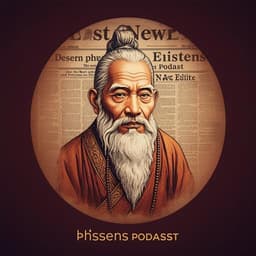
Humanities
Linguistic purification of violence in the press: a comparative critical discourse analysis of execution news
O. Bunnag and K. Chaemsaithong
Discover how Thai newspapers have shaped societal perceptions of capital punishment over two decades in a groundbreaking study by Orawee Bunnag and Krisda Chaemsaithong. This research unveils the linguistic strategies that normalize state executions, revealing a consistent ideological stance despite changing narratives. Dive into the subtlety of language that influences public belief surrounding the death penalty.
~3 min • Beginner • English
Introduction
The study investigates how Thai newspaper execution reports construct public beliefs about capital punishment through subtle linguistic choices. While many nations have abolished the death penalty, support remains high in Thailand (surveys from 1980–2020 show 69–99% in favor). Prior work suggests support is shaped culturally via everyday discourse that purifies state killing and removes it from public view. This research applies critical discourse analysis to examine the centrality of language in shaping perceptions of state executions and offenders. Using a corpus of Thai execution news spanning 1997–2017 and covering the transition from firing squad to lethal injection, the study asks: (1) What are the forms and pragmatic effects of representational strategies (people, events, speech) in these reports? (2) What shifts, if any, occur with the move to lethal injection? (3) What messages do these choices convey about capital punishment? The study aims to reveal how ostensibly objective reports normalize and legitimize executions, contributing to understanding the social construction of crime and punishment in Thai media and offering insights for other contexts.
Literature Review
The study draws on functional linguistics and critical discourse analysis. It adopts van Leeuwen’s (2008) social actor framework (nomination, categorization via functionalization and identification, and impersonalization) to analyze how people are referenced, including agency concealment via omission or metonymy. It uses Halliday’s (1994) transitivity system (material, behavioral, mental, verbal, relational, existential processes) to examine event representation and agency/responsibility, noting how passivization and existential/nominalized forms can obscure agents. Intertextuality is examined via inclusion/exclusion of voices (verbal and mental processes), recognizing how quoted speakers shape perceived legitimacy. Prior CDA studies show: press use of pejorative labels (“fiend naming”), overuse of identifications highlighting age/ethnicity for offenders, and privileging police/expert voices while marginalizing minorities (Clark 1992; Teo 2000; Jewkes 2015; Machin & Mayr 2013; Tabbert 2015). Execution-report studies (Halmari 1999; Halmari & Östman 2001; Suriya 2011) find minimized depictions of death, agent suppression, sensational labeling of offenders, and pro-death framing via local quotes. This study extends prior work with a larger, diachronic Thai corpus, systematically cataloging reference/process/voice choices and their ideological effects across the shift to lethal injection.
Methodology
Data: 108 execution news reports from quality Thai newspapers archived at the National Library of Thailand, divided into two periods: Period 1 (1997–2002; firing squad; 69 reports covering 41 executed individuals: 28 murder, 13 drug trafficking) and Period 2 (2003–2017; lethal injection; 39 reports covering 7 executed individuals: 2 murder, 5 drug trafficking). Articles are execution reports proper (e.g., excluding editorials). Some individuals have multiple reports from different outlets, allowing cross-outlet comparison. Reports are in Thai and English; Thai items were directly translated and cross-checked by two language experts to preserve lexico-grammatical features relevant to ideational meanings. Contextual description of Thai execution methods is provided (firing squad procedure; lethal injection protocol and debates over its humaneness and practical issues).
Analytic procedure: Researchers identified all reference expressions for major social actors (executed individuals, executioners, victims) in headlines and body using van Leeuwen’s categories (nomination, categorization, impersonalization), counting each representational element (e.g., titles, functional and identification labels). Process types (Halliday) involving these actors were coded (material, behavioral, mental, verbal, relational, existential), alongside grammatical operations that affect agency (passivization, nominalization, agent omission). For verbal and mental processes, the study cataloged whose voices were included/excluded and their functions. Coding was conducted independently by both researchers with discrepancies discussed and resolved. Frequencies are reported as percentages within each period to address different sample sizes.
Key Findings
Headline representations:
1) Executed individuals are the main element, overwhelmingly in functional terms; executioners are excluded/impersonalized; victims seldom appear.
- Executed in functional terms: 93% (Period 1), 95% (Period 2).
- Executioners excluded or impersonalized: 98% (Period 1), 100% (Period 2).
- Victims in headlines mainly for sensational cases: 6% (Period 1), 2% (Period 2).
2) Explicit negative evaluations decline over time, but pro-death stance remains.
- Period 1 headlines often include explicit derogations (e.g., “brutal,” dehumanizing labels).
- Period 2: explicit evaluations in only 2% of headlines, but 85% include frequency adverbials (e.g., “first time in 9 years,” “2nd time in 6 years”) implying executions are rare/selective, enhancing perceived legitimacy/newsworthiness.
3) State killing is framed with non-violent material processes and suppressed agents.
- Period 1 headline process lexemes: “execute” 78%; “target-shoot” 13%; onomatopoeic “bang-bang” 7%; others 2% (e.g., “live show,” “settle accounts with”).
- Period 2 headline process lexemes: “give a shot to execute” 96%; “execute” 2%; others 2% (e.g., “put to death,” “use 3 drugs,” “inject poison”). Agents are omitted or institutionalized (e.g., via nominalization or metonymy), and executions are medicalized/bureaucratized.
4) Behavioral, mental, and relational processes depict executed persons’ reactions.
- Period 1 emphasizes resistance/technical issues (e.g., “screams,” “need to fire 2 rounds”).
- Period 2 highlights smooth, quick, painless procedures (e.g., “only takes 25 minutes,” “all goes well”), with reported access to “final moments.”
Body content representations:
5) Overlexicalization and repetition for condemned and victims.
- Repeated titles like “convicted prisoner + name” dominate subsequent mentions (95% Period 1; 97% Period 2), reinforcing criminal identity; victims also over-specified to amplify vulnerability/harm.
6) Executioners’ identities recede; personalization disappears in Period 2.
- Period 1 names/ranks of executioners are given (nomination). Period 2 uses generalized functional terms (“a prison officer from the Department of Corrections”), removing personal accountability and hindering public scrutiny.
7) Executed individuals’ actions are materially agentive; executioners’ actions are procedural and agent-suppressed.
- Executed: material processes dominate (89% Period 1; 91% Period 2), detailing unlawful acts and harms; additional behavioral/mental processes depict deviance.
- Executioners: descriptions focus on equipment/steps; in Period 2, agents are institutionalized/omitted (passives, nominalizations), e.g., “the prison kept… and had them lie…,” “three syringes [verb omitted] beside each man.”
8) Voices of the powerful dominate; dissenting/condemned voices marginalized.
- Distribution of quoted voices:
• State personnel: 49% (Period 1), 62% (Period 2)
• Monks: 11% (Period 1), 12% (Period 2)
• Execution witnesses (reporters): 22% (Period 1), 14% (Period 2)
• Executed individuals: 18% (Period 1), 10% (Period 2)
• Death penalty opponents: 0% (Period 1), 2% (Period 2)
- Quoted state/monastic voices endorse deterrence, humaneness, and procedural success; executed individuals’ quotes dramatize last moments; only one article includes an opposing view (Amnesty International), offering limited balance.
Overall: Across both periods, linguistic choices purify and normalize state killing by minimizing/concealing state agency, dehumanizing offenders, medicalizing the act, and privileging supportive elite voices; Period 2 shows reduced explicit negative evaluation and anonymized executioners without altering the underlying pro-death ideological stance.
Discussion
The findings answer the research questions by detailing the forms and pragmatic effects of representational strategies. Systematic use of functional labels for the condemned, agent suppression for executioners, non-violent/medicalized process choices, and selective intertextuality collectively sanitize state killing and differentiate it from criminal violence, aligning readers with a pro-death penalty stance. The diachronic comparison shows that after the adoption of lethal injection, explicit negative evaluation decreases and executioners become anonymized, yet the press’s ideological positioning remains stable: executions are framed as routine, humane, and effective, while offenders are constructed as deserving punishment. By privileging official/elite voices and marginalizing dissenting or inmate perspectives, reports foreclose debate and hinder democratic scrutiny (e.g., of executioners’ qualifications or procedural failures). These discursive practices likely shape public opinion by presenting executions as rare, orderly, and justified, reinforcing dominant crime-control ideologies and obscuring potential injustices (botched procedures, wrongful convictions, structural causes of crime). The study illuminates how language choices in ostensibly factual reporting have ideological effects, contributing to broader media-driven governance through crime.
Conclusion
The study demonstrates that Thai press execution reports purify and normalize state killing through coordinated representational strategies: offenders are dehumanized via functional labels and overlexicalization, executioners are professionalized and later anonymized, killing is medicalized and agent-suppressed, and supportive official/monastic voices dominate while opposing or inmate perspectives are minimized. Diachronically, despite reduced explicit evaluative language and increased anonymization in the lethal injection era, the pro-death ideological stance persists. These findings align with cross-cultural patterns in crime reporting, suggesting broader media tendencies to construct ideal offenders/victims and legitimize punitive policies. By exposing subtle linguistic mechanisms, the study lays groundwork for more informed public understanding of executions and invites comparative inquiry in other national contexts and media genres. Future research could expand to other media formats, longer time spans, and multimodal analyses to assess how visual and textual resources jointly construct the legitimacy of state killing.
Limitations
The study acknowledges and/or implies several limitations: (1) Unequal sample sizes between periods (69 vs. 39 articles), though results are reported in percentages to mitigate imbalance. (2) Focus on quality Thai newspapers archived at the National Library; findings may not generalize to tabloids, broadcast, social media, or non-archived outlets. (3) Exclusion of non-execution pieces (e.g., editorials) limits perspective to report genres that typically avoid explicit debate. (4) Translation of Thai reports into English, while cross-checked and focused on ideational meanings, may still introduce subtle interpretive shifts. (5) The analysis centers on textual features; multimodal elements (images/layout) are not examined. (6) The study pertains to Thailand (1997–2017); cross-cultural generalizations should be made cautiously.
Related Publications
Explore these studies to deepen your understanding of the subject.







